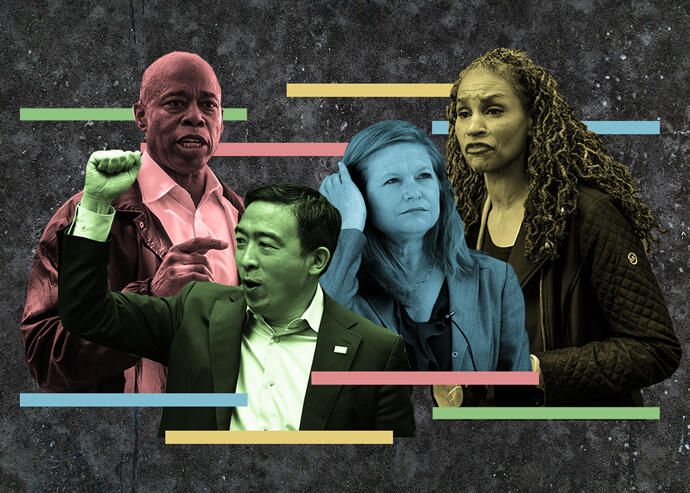
From left: Mayoral candidates Eric Adams, Andrew Yang, Kathryn Garcia and Maya Wiley (Getty)
It’s still anyone’s guess who will win the Democratic primary for mayor of New York City. But no one is guessing Scott Stringer, Shaun Donovan or Ray McGuire.
A phone poll conducted five weeks before the June 22 primary shows the three candidates struggling for traction despite their ample war chests peppering voters’ screens with ads.
The survey also thrusts Brooklyn Borough President Eric Adams into the role of favorite and elevates Kathryn Garcia from dark horse to contender. Both are welcome developments for the real estate industry, which is hoping for a more effective and less ideological mayor when Bill de Blasio’s eight long years in City Hall end Dec. 31.
Former front-runner Andrew Yang runs second in the poll of 800 likely primary voters surveyed by Core Decision Analytics for government affairs consultancy Fontas Advisors. Yang seems to be clinging to his support while Garcia, a former Department of Sanitation commissioner, is gaining.
“Eric Adams has clearly caught Yang and solidified his position in the top tier if not in the top spot,” said George Fontas, head of his eponymous firm. “Garcia has made an enormous leap in a short period of time.”
Garcia was propelled by, of all things, newspaper endorsements — a once-coveted validation whose importance has dwindled along with circulations. But winning the backing of the New York Times and Daily News gave voters something to go on in what some might have seen as a nebulous field of eight major candidates.
Adams, a former NYPD captain, earned the right-leaning New York Post’s endorsement, but his ascendance has more to do with the elevation of crime as a concern.
“Eric Adams and Garcia both have terrific momentum,” said Fontas. “Yang has to reverse course or regain momentum.”
The poll numbers are still splintered and must be preceded by a caveat: They combine sure-of-their-choice voters with those who initially said “undecided” but then acknowledged leaning toward a candidate. Adams has 18 percent, Yang 13 percent and Garcia 11 percent. The race’s two most liberal candidates, Maya Wiley and Dianne Morales, each have 9 percent.
Then comes the city comptroller, Stringer, with a paltry 7 percent, followed by the two 4-percenters, former Obama housing secretary Donovan and ex-investment banker McGuire.
Stringer had thought slamming developers was the way to complete his methodical rise through New York City politics — from Upper West Side Assembly member to Manhattan borough president to comptroller — with a City Hall gig. Alas, his attempt at populism was a bad match for his uncharismatic demeanor and never resonated with New Yorkers, leaving him vulnerable to any setback.
That setback came when a former girlfriend (his characterization) or acquaintance (hers) accused Stringer of unwanted sexual advances two decades ago, and many of his endorsers fled.
Donovan was positioned as the housing expert in the race but undermined that premise by incorrectly guessing the median sale price of a Brooklyn home. McGuire’s even lower estimate reinforced the impression that he is an out-of-touch Wall Streeter. But neither man had any momentum to lose anyway.
“If I’m McGuire and Donovan, I’m going to start reassessing my path to victory,” said Fontas. “They’re not catching fire for months. It’s hard to believe that they will now.”
If Donovan is the wonk candidate, Wiley is the woke candidate. The police-bashing, de Blasio–deserting lawyer has steadily inched up after a sluggish start. So has Morales, though if the former nonprofit executive were to emerge as a threat, her rivals would surely spend more time reminding New Yorkers that she once paid off a city inspector to make a runaway water bill evaporate.
Negative stories, meanwhile, have bounced off Adams, as none rose to a level that voters deemed scandalous: He was a Republican until 20 years ago; he boosted a gaming company vying to run a city casino; he raised money for a self-promotional magazine. The collective reaction of pandemic-weary New Yorkers: And?
Still, with more than a quarter of poll respondents saying they are not even leaning toward a candidate yet, the race remains fluid.
“At this point,” said Fontas, “one great ad, one foot-in-the-mouth moment, can point the 26 percent of undecided in a whole new direction.”



